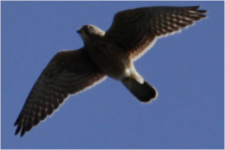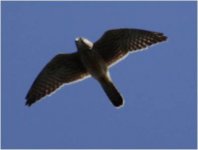-
Welcome to BirdForum, the internet's largest birding community with thousands of members from all over the world. The forums are dedicated to wild birds, birding, binoculars and equipment and all that goes with it.
Please register for an account to take part in the discussions in the forum, post your pictures in the gallery and more.
You are using an out of date browser. It may not display this or other websites correctly.
You should upgrade or use an alternative browser.
You should upgrade or use an alternative browser.
Falcon ID (Attenborough, England) (1 Viewer)
- Thread starter NKR2017
- Start date
More options
Who Replied?Jane Turner
Well-known member
maybe its re-growing
Nutcracker
Stop Brexit!
Angled up with the bird hanging in the wind.Looks like its got a hell of a short tail for a Kestrel...
Tho' it does look very like it's transplanted off a Jay 3
All at once? It would be difficult for it to survive long enough for its tail to regrow if it had lost all of it in one go.. Maybe its a stunted mutation? Maybe its just the angle?maybe its re-growing
All at once? It would be difficult for it to survive long enough for its tail to regrow if it had lost all of it in one go.. Maybe its a stunted mutation? Maybe its just the angle?
Pretty sure it's the angle here.
Birds do not die if they accidentally lose their tail (correct me if you have even one bit of evidence (published articles) for the contrary).
It only takes a few weeks for the tail to be partly regrown, and although the flight capability will be slightly down for a short period, birds are quite adaptable such situations.
A Kestrel with less ability to effeciently hover, will do so all the same, and still find food, and/or it will resort to hunting from a perch instead.
For thousands of species the temporary lack of the tail will have absolutely no detrimental effect on the feeding success.
Do consider that in the cause of a normal moult, numerous species come close to having practically no tail for a brief period.
Peter
Last edited:
Birds do not die if they accidentally lose their tail
That's a pretty bold statement... Birds can and do die from any disadvantage..
According to the Scottish Raptor Study Group up to 60% of Kestrels die in their first winter... Further a BTO survey show a 67% reduction in numbers in Scotland...
I'm not sure how old this data is... but it does demonstrate any disadvantage can be deadly given able bodied individuals still struggle to survive...
Raptors do not normally come close to losing their entire tail during moults...
Last edited:
Birds do not die if they accidentally lose their tail
That's a pretty bold statement... Birds can and do die from any disadvantage..
According to the Scottish Raptor Study Group up to 60% of Kestrels die in their first winter... Further a BTO survey show a 67% reduction in numbers in Scotland...
I'm not sure how old this data is... but it does demonstrate any disadvantage can be deadly given able bodied individuals still struggle to survive...
Raptors do not normally come close to losing their entire tail during moults...
My statement was "bold", because in my 36 years of receiving birds for taxidermy, I have never received any where a missing tail was the cause of death.
And I haven't heard anything from collegeues all over the World that could back up your claim.
Nor have I read articles/seen surveys to indicate so.
My common sense (accumulated general knowledge of birds) also shakes its head.
Therefore I simply do not find it likely that you're right.
Furthermore it must be extremely rare for raptors to loose all tail feathers by an accident, which still leaves the bird totally alive and kicking.
But much more common for a Blackbird in the UK with millions of domestic cats lurking in the bushes.....
But of course you're right in your general (and proven) facts regarding mortality of young raptors, but I asked for specific proof that an accidentally lost tail will cause a bird to die before the tail is regrown.
Ask yourself how much a Griffon Vulture, a Great Northern Diver, an Ostrich, a Wren, a Mallard or a Reeves Pheasant will be deprived of its ability to feed were the tail-feathers plucked?
Peter
Last edited:
My statement was "bold", because in my 36 years of receiving birds for taxidermy, I have never received any where a missing tail was the cause of death.
And I haven't heard anything from collegeues all over the World that could back up your claim.
Nor have I read articles/seen surveys to indicate so.
My common sense (accumulated general knowledge of birds) also shakes its head.
Therefore I simply do not find it likely that you're right.
Furthermore it must be extremely rare for raptors to loose all tail feathers by an accident, which still leaves the bird totally alive and kicking.
But much more common for a Blackbird in the UK with millions of domestic cats lurking in the bushes.....
But of course you're right in your general (and proven) facts regarding mortality of young raptors, but I asked for specific proof that an accidentally lost tail will cause a bird to die before the tail is regrown.
Ask yourself how much a Griffon Vulture, a Great Northern Diver, an Ostrich, a Wren, a Mallard or a Reeves Pheasant will be deprived of its ability to feed were the tail-feathers plucked?
Peter
Hello Pete...... It's common sense.. Do you really think if someone found a dead Kestrel without a tail they would take the trouble of taking it to a taxidermist?
Almost all wild birds die without being found, and its infinitely more unlikely (not impossible) you'll find a dead one without a tail.. many die without proof of why they died.. Take away a key tool for their survival it could prove fatal, and given the horrendous survival rates for birds no so impaired its reasonable to assume this will hamper the survival of an individual bird..
The only bird you mention which would have some difficulty for a short while is probably the Griffon Vulture.. I can't really see how a ground dwelling or a bird living on the water could be impacted much either with the temporary loss of its tail.. Most wildfowl lose all of their flight feathers during the moult..
The intention of my posts (responding to what I thought was a general claim encompassing all birds, not solely raptors), was to argue that a temporary loss of the tail feathers would not be likely to prove fatal.
And even if we limit ourselves to discuss only raptors, I could argue that I've seen several tail-less birds of prey, mostly Black Kites, (albeit only a very minute fraction of all the normal ones) crossing the Gibraltar, something a bird in ill condition would hardly do.
However, I do see where you're coming from, and I believe we agree on the vital points made here
Peter
And even if we limit ourselves to discuss only raptors, I could argue that I've seen several tail-less birds of prey, mostly Black Kites, (albeit only a very minute fraction of all the normal ones) crossing the Gibraltar, something a bird in ill condition would hardly do.
However, I do see where you're coming from, and I believe we agree on the vital points made here
Peter
Last edited:
Andy Adcock
Worst person on Birdforum

Let me be controversial for a change..8-P
Can we dismiss another, smaller Falcon of captive origin? The whole thing including bill structure looks odd to me for Kestrel?
A
Can we dismiss another, smaller Falcon of captive origin? The whole thing including bill structure looks odd to me for Kestrel?
A

it looks perfectly normal for a fresh juvenile Common Kestrel to my eyes. Shortish tail due to angle for sure, juveniles learning to fly surely move tail much more than adults.
As to tailless raptors I have seen many and it is astonishing how well they do flying without tail
As to tailless raptors I have seen many and it is astonishing how well they do flying without tail
it looks perfectly normal for a fresh juvenile Common Kestrel to my eyes. Shortish tail due to angle for sure, juveniles learning to fly surely move tail much more than adults.
As to tailless raptors I have seen many and it is astonishing how well they do flying without tail
Agree in everything here.
The position of the bird in question makes it most likely that a gush of wind lifts the tail in the instant the picture was taken, thus giving a false impression of it having an abnormally short tail.
Peter
stevethehydra
Well-known member
My first thought on this was that it does look oddly like an American Kestrel... but plumage-wise it looks perfectly normal for Common/Eurasian K and I think it is most likely to just be an odd photo angle, maybe combined with feathers being momentarily fluffed up in such a way as to mislead about structure/proportions. Perhaps also just a bird that is at the extreme end of the bell curve in size/structure - all species do have individual variation...
This is true for the larger falcon species (Peregrines, Gyrs, Lanners, Sakers etc)... and there is also a weird trend for crossing those larger species with Merlins through AI, but I have never heard of any Kestrel sp being used in captive hybridisation - Ken Loach aside, I think they are just not attractive to "big business" falconry due to their preferred prey and hunting style (Merlins, while also small, are at least also pursuit hunters, which is what the falconers want at various combinations of size/speed/flight range/etc...)
The captive breeding community is rife with hybrids. Busily destroying the captive gene pool.. This bird certainly doesn't look right.. They'll A.I. anything..
This is true for the larger falcon species (Peregrines, Gyrs, Lanners, Sakers etc)... and there is also a weird trend for crossing those larger species with Merlins through AI, but I have never heard of any Kestrel sp being used in captive hybridisation - Ken Loach aside, I think they are just not attractive to "big business" falconry due to their preferred prey and hunting style (Merlins, while also small, are at least also pursuit hunters, which is what the falconers want at various combinations of size/speed/flight range/etc...)
Jon Turner
Well-known member
There was a Lesser Kestrel flying around Jimena de la Frontera last year with no tail at all. Didn't seem to worry it at all. Although it did look odd (like a short-tailed Nighthawk!). It was in the spring and at a breeding colony too.
Users who are viewing this thread
Total: 2 (members: 0, guests: 2)





